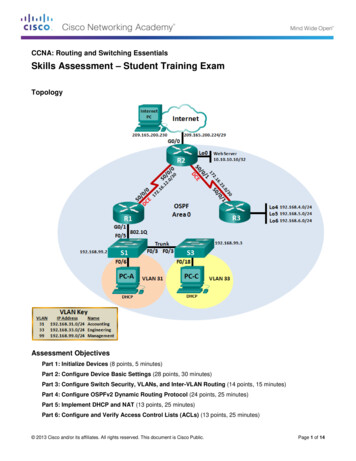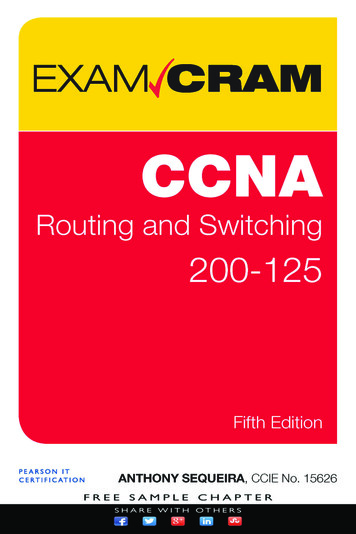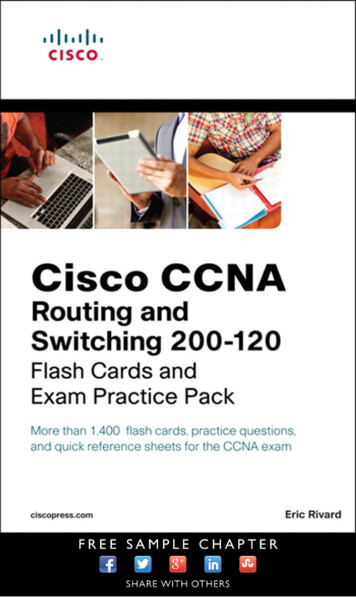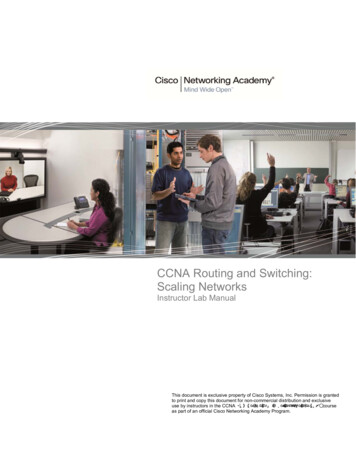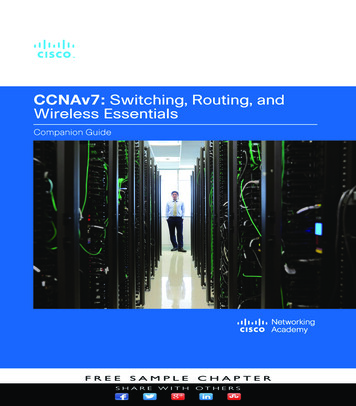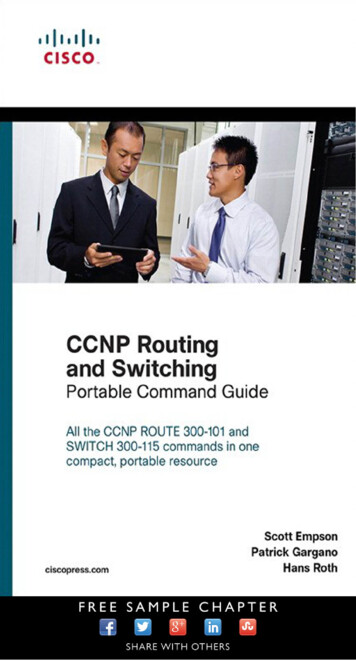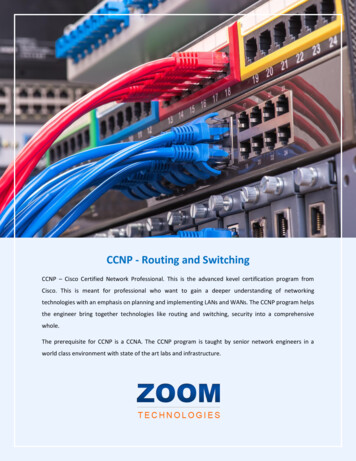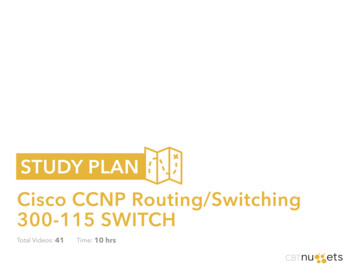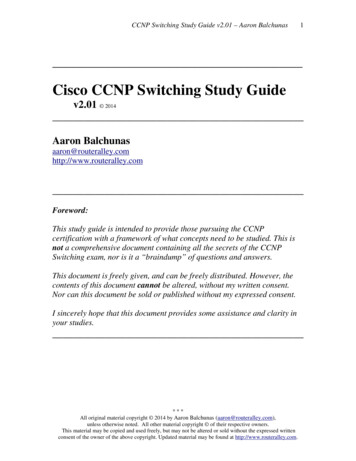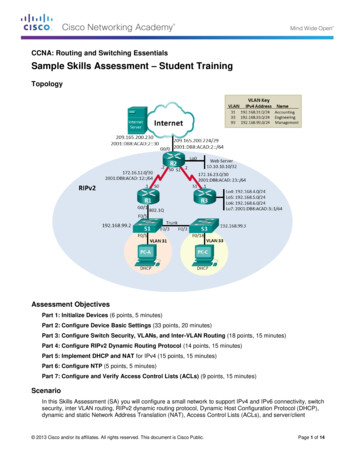
Transcription
CCNA: Routing and Switching EssentialsSample Skills Assessment – Student TrainingTopologyAssessment ObjectivesPart 1: Initialize Devices (6 points, 5 minutes)Part 2: Configure Device Basic Settings (33 points, 20 minutes)Part 3: Configure Switch Security, VLANs, and Inter-VLAN Routing (18 points, 15 minutes)Part 4: Configure RIPv2 Dynamic Routing Protocol (14 points, 15 minutes)Part 5: Implement DHCP and NAT for IPv4 (15 points, 15 minutes)Part 6: Configure NTP (5 points, 5 minutes)Part 7: Configure and Verify Access Control Lists (ACLs) (9 points, 15 minutes)ScenarioIn this Skills Assessment (SA) you will configure a small network to support IPv4 and IPv6 connectivity, switchsecurity, inter VLAN routing, RIPv2 dynamic routing protocol, Dynamic Host Configuration Protocol (DHCP),dynamic and static Network Address Translation (NAT), Access Control Lists (ACLs), and server/client 2013 Cisco and/or its affiliates. All rights reserved. This document is Cisco Public.Page 1 of 14
CCNA: Routing and Switching EssentialsSA Answer KeyNetwork Time Protocol (NTP). You will test and document the network using common CLI commandsthroughout the assessment.Required Resources 3 Routers (Cisco 1941 with Cisco IOS Release 15.4(3)M2 universal image or comparable) 2 Switches (Cisco 2960 with Cisco IOS Release 15.0(2)SE7 lanbasek9 image or comparable) 3 PCs (Windows 7, Vista, or XP with terminal emulation program, such as Tera Term) Console cable to configure the Cisco IOS devices via the console ports Ethernet and Serial cables as shown in the topologyPart 1: Initialize DevicesTotal points: 6Time: 5 minutesStep 1: Initialize and reload the routers and switches.Erase the startup configurations and reload the devices.Before proceeding, have your instructor verify device initializations.TaskIOS CommandPointsErase the startup-config file on allrouters.1½ points(½ pointperrouter)Reload all routers.1½points (½point perrouter)Erase the startup-config file on allswitches and remove the oldVLAN database.1 point(½ pointperswitch)Reload both switches.1 point(½ pointperswitch)Verify VLAN database is absentfrom flash on both switches.1 point(½ pointperswitch)Instructor Sign-off Part 1:Points: of 6Part 2: Configure Device Basic SettingsTotal points: 30 2013 Cisco and/or its affiliates. All rights reserved. This document is Cisco Public.Page 2 of 14
CCNA: Routing and Switching EssentialsSA Answer KeyTime: 20 minutesStep 1: Configure the Internet PC.Configuration tasks for the Internet Server include the following (refer to the Topology for IP addressinformation):Configuration Item or TaskSpecificationPointsIPv4 Address(1/2 point)IPv4 Subnet Mask(1/2 point)Default Gateway209.165.200.225N/AIPv6 Address/SubnetIPv6 Default Gateway(1/2 point)2001:DB8:ACAD:2::1N/ANote: It may be necessary to disable the PC firewall for pings to be successful later in this lab.Step 2: Configure R1.Configuration tasks for R1 include the following:Configuration Item or TaskSpecificationDisable DNS lookupPoints(1/2 point)Router nameR1(1/2 point)Encrypted privileged exec passwordclass(1/2 point)Console access passwordcisco(1/2 point)Telnet access passwordcisco(1/2 point)Encrypt the clear text passwords(1/2 point)MOTD bannerUnauthorized Access is Prohibited!(1/2 point)Interface S0/0/0Set the descriptionSet the IPv4 address. Refer to Topology diagram foraddress information.Set the IPv6 address. Refer to Topology diagram foraddress information.Set the clocking rate to 128000Activate Interface(1 point)Default routesConfigure a default IPv4 route out S0/0/0.Configure a default IPv6 route out S0/0/0(1 point)Note: Do not configure G0/1 at this time.Step 3: Configure R2.Configuration tasks for R2 include the following: 2013 Cisco and/or its affiliates. All rights reserved. This document is Cisco Public.Page 3 of 14
CCNA: Routing and Switching EssentialsSA Answer KeyConfiguration Item or TaskSpecificationDisable DNS lookupPoints(1/2 point)Router nameR2(1/2 point)Encrypted privileged exec passwordclass(1/2 point)Console access passwordcisco(1/2 point)Telnet access passwordcisco(1/2 point)Encrypt the clear text passwords(1/2 point)Enable HTTP server(1/2 point)MOTD bannerUnauthorized Access is Prohibited!(1/2 point)Interface S0/0/0Set the descriptionSet the IPv4 address. Use the next availableaddress in the subnet.Set the IPv6 address. Refer to Topology diagramfor address information.Activate Interface(1 point)Interface S0/0/1Set the descriptionSet the IPv4 address. Use the first availableaddress in the subnet.Set the IPv6 address. Refer to Topology diagramfor address information.Set clocking rate to 128000Activate Interface(1 point)Interface G0/0 (Simulated Internet)Set the DescriptionSet the IPv4 address. Use the first availableaddress in the subnet.Set the IPv6 address. Use the first availableaddress in the subnet.Activate Interface(1 point)Interface Loopback 0 (Simulated WebServer)Set the description.Set the IPv4 address.(1/2 point)Default routeConfigure a default IPv4 route out G0/0.Configure a default IPv6 route out G0/0.(1 point)Step 4: Configure R3.Configuration tasks for R3 include the following: 2013 Cisco and/or its affiliates. All rights reserved. This document is Cisco Public.Page 4 of 14
CCNA: Routing and Switching EssentialsConfiguration Item or TaskSA Answer KeySpecificationDisable DNS lookupPoints(1/2 point)Router nameR3(1/2 point)Encrypted privileged exec passwordclass(1/2 point)Console access passwordcisco(1/2 point)Telnet access passwordcisco(1/2 point)Encrypt the clear text passwords(1/2 point)MOTD bannerUnauthorized Access is Prohibited!(1/2 point)Interface S0/0/1Set the descriptionSet the IPv4 address. Use the next available addressin the subnet.Set the IPv6 address. Refer to Topology diagram foraddress information.Activate Interface(1 point)Interface Loopback 4Set the IPv4 address. Use the first available addressin the subnet.(1/2 point)Interface Loopback 5Set the IPv4 address. Use the first available addressin the subnet.(1/2 point)Interface Loopback 6Set the IPv4 address. Use the first available addressin the subnet.(1/2 point)Interface Loopback 7Set the IPv6 address. Refer to Topology diagram foraddress information.(1/2 point)Default routesConfigure a default IPv4 route out S0/0/1.Configure a default IPv6 route out S0/0/1.(1 point)Step 5: Configure S1.Configuration tasks for S1 include the following: 2013 Cisco and/or its affiliates. All rights reserved. This document is Cisco Public.Page 5 of 14
CCNA: Routing and Switching EssentialsSA Answer KeyConfiguration Item or TaskSpecificationDisable DNS lookupPoints(1/2 point)Switch nameS1(1/2 point)Encrypted privileged exec passwordclass(1/2 point)Console access passwordcisco(1/2 point)Telnet access passwordcisco(1/2 point)Encrypt the clear text passwordsMOTD banner(1/2 point)Unauthorized Access is Prohibited!(1/2 point)Step 6: Configure S3Configuration tasks for S3 include the following:Configuration Item or TaskSpecificationDisable DNS lookupPoints(1/2 point)Switch nameS3(1/2 point)Encrypted privileged exec passwordclass(1/2 point)Console access passwordcisco(1/2 point)Telnet access passwordcisco(1/2 point)Encrypt the clear text passwordsMOTD banner(1/2 point)Unauthorized Access is Prohibited!(1/2 point)Step 7: Verify network connectivity.Use the ping command to test connectivity between network devices.Use the following table to methodically verify connectivity with each network device. Take corrective action toestablish connectivity if a test fails:FromToIP AddressPing ResultsPointsR1R2, S0/0/0(1 point)R2R3, S0/0/1(1 point)Internet PCDefault Gateway(1 point)Note: It may be necessary to disable the PC firewall for pings to be successful.Instructor Sign-off Part 2:Points: of 33 2013 Cisco and/or its affiliates. All rights reserved. This document is Cisco Public.Page 6 of 14
CCNA: Routing and Switching EssentialsSA Answer KeyPart 3: Configure Switch Security, VLANS, and Inter VLAN RoutingTotal points: 18Time: 15 minutesStep 1: Configure S1.Configuration tasks for S1 include the following:Configuration Item or TaskSpecificationPointsCreate the VLAN databaseUse Topology VLAN Key table to create and nameeach of the listed VLANS.(1 point)Assign the management IP address.Assign the IPv4 address to the Management VLAN.Use the IP address assigned to S1 in the Topologydiagram.(1/2 point)Assign the default-gatewayAssign the first IPv4 address in the subnet as thedefault-gateway.(1/2 point)Force trunking on Interface F0/3Use VLAN 1 as the native VLAN.(1 point)Force trunking on Interface F0/5Use VLAN 1 as the native VLAN.(1 point)Configure all other ports as accessportsUse the interface range command.(1/2 point)Assign F0/6 to VLAN 31(1/2 point)Shutdown all unused ports(1/2 point)Step 2: Configure S3.Configuration tasks for S3 include the following:Configuration Item or TaskSpecificationPointsCreate the VLAN databaseUse Topology VLAN Key Table to create each of thelisted VLANS. Name each VLAN.(1 point)Assign the management IP addressAssign the IPv4 address to the Management VLAN.Use the IP address assigned to S3 in the Topologydiagram.(1/2 point)Assign the default-gatewayAssign the first IP address in the subnet as thedefault-gateway.(1/2 point)Force trunking on Interface F0/3Use VLAN 1 as the native VLAN.(1 point)Configure all other ports as accessportsUse the interface range command.(1/2 point)Assign F0/18 to VLAN 33(1/2 point)Shutdown all unused ports(1/2 point) 2013 Cisco and/or its affiliates. All rights reserved. This document is Cisco Public.Page 7 of 14
CCNA: Routing and Switching EssentialsSA Answer KeyStep 3: Configure R1.Configuration tasks for R1 include the following:Configuration Item or TaskSpecificationPointsConfigure 802.1Q subinterface .31 onG0/1Description Accounting LANAssign VLAN 31.Assign the first available address to this interface.(1 point)Configure 802.1Q subinterface .33 onG0/1Description Engineering LANAssign VLAN 33.Assign the first available address to this interface.(1 point)Configure 802.1Q subinterface .99 onG0/1Description Management LANAssign VLAN 99.Assign the first available address to this interface.(1 point)Activate Interface G0/1(1 point)Step 4: Verify network connectivity.Use the ping command to test connectivity between the switches and R1.Use the following table to methodically verify connectivity with each network device. Take corrective action toestablish connectivity if a test fails:FromToIP AddressPing ResultsPointsS1R1, VLAN 99 address(1 point)S3R1, VLAN 99 address(1 point)S1R1, VLAN 31 address(1 point)S3R1, VLAN 33 address(1 point)Instructor Sign-off Part 2:Points: of 18Part 4: Configure RIPv2 Dynamic Routing ProtocolTotal points: 14Time: 15 minutesStep 1: Configure RIPv2 on R1.Configuration tasks for R1 include the following: 2013 Cisco and/or its affiliates. All rights reserved. This document is Cisco Public.Page 8 of 14
CCNA: Routing and Switching EssentialsSA Answer KeyConfiguration Item or TaskSpecificationConfigure RIP Version 2Advertise directly connected NetworksPoints(1 point)Assign all directly connectednetworks.(1 point)Set all LAN interfaces as passive(1 point)Disable automatic summarization(1 point)Step 2: Configure RIPv2 on R2.Configuration tasks for R2 include the following:Configuration Item or TaskSpecificationConfigure RIP Version 2Advertise directly connected NetworksPoints(1 point)Note: Omit the G0/0 network.(1 point)Set the LAN (Loopback) interface as passive(1 point)Disable automatic summarization(1/2 point)Step 3: Configure RIPv2 on R3.Configuration tasks for R3 include the following:Configuration Item or TaskSpecificationPointsConfigure RIP Version 2(1 point)Advertise directly connected IPv4 Networks(1 point)Set all IPv4 LAN (Loopback) interfaces as passive(1 point)Disable automatic summarization(1/2 point)Step 4: Verify RIP information.Verify that RIP is functioning as expected. Enter the appropriate CLI command to discover the followinginformation: 2013 Cisco and/or its affiliates. All rights reserved. This document is Cisco Public.Page 9 of 14
CCNA: Routing and Switching EssentialsSA Answer KeyQuestionResponsePointsWhat command displays the RIP Process ID, Router ID,Routing Networks, and passive interfaces configured on arouter?(1 point)What command displays only RIP routes?(1 point)What command displays the RIP section of the runningconfiguration?(1 point)Instructor Sign-off Part 3:Points: of 14Part 5: Implement DHCP and NAT for IPv4Total points: 15Time: 15 minutesStep 1: Configure R1 as the DHCP server for VLANs 31 and 33.Configuration tasks for R1 include the following:Configuration Item or TaskSpecificationPointsReserve the first 20 IP addresses inVLAN 31 for static configurations(1 point)Reserve the first 20 IP addresses inVLAN 33 for static configurations(1 point)Create a DHCP pool for VLAN 31Name: ACCTDNS-Server: 10.10.10.10Domain-Name: ccna-sa.comSet the default gateway.(1 point)Create a DHCP pool for VLAN 33Name: ENGNRDNS-Server: 10.10.10.10Domain-Name: ccna-sa.comSet the default gateway.(1 point)Step 2: Configure Static and Dynamic NAT on R2.Configuration tasks for R2 include the following: 2013 Cisco and/or its affiliates. All rights reserved. This document is Cisco Public.Page 10 of 14
CCNA: Routing and Switching EssentialsConfiguration Item or TaskCreate a local database with 1 useraccountSA Answer KeySpecificationUsername: webuserPassword: cisco12345Privilege level: 15Points(1 point)Enable HTTP server service(1/2 point)Configure the HTTP server to use thelocal database for authentication(1/2 point)Create a static NAT to the Web ServerInside Global Address: 209.165.200.229Assign the inside and outside interfacefor the static NAT(1 point)(1 point)Configure the dynamic NAT insideprivate ACLAccess List: 1Allow the Accounting and Engineering networks onR1 to be translated.Allow a summary of the LANs (loopback) networkson R3 to be translated.(1 point)Define the po
This document is Cisco Public. Page 1 of 14 CCNA: Routing and Switching Essentials Sample Skills Assessment – Student Training Topology Assessment Objectives Part 1: Initialize Devices (6 points, 5 minutes) Part 2: Configure Device Basic Settings (33 points, 20 minutes) Part 3: Configure Switch Security, VLANs, and Inter-VLAN Routing (18 points, 15 minutes) Part 4: Configure RIPv2 Dynamic .
